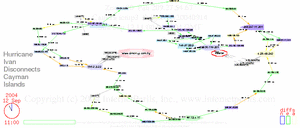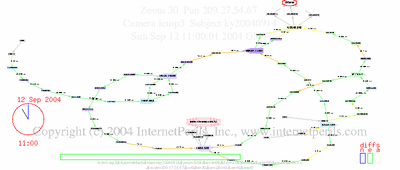In his book Linked, Albert-László Barabási (ALB) remarks:
“Real networks are not static, as all graph theoretical models were until recently. Instead growth plays a key role in shaping their topology. They are not as centralized as a start network is. Rather, there is a hierarchy of hubs that keep these networks together, a heavily connected node closely followed by several less connected ones, trailed by dozens of even smaller nodes. No central node sits in the middle of the spider web, controlling and monitoring every link and node. There is no single node whose removal could break the web. A scale-free network is a web without a spider.”
This is not news to those of us who were involved in USENET. For example, I ran ut-sally, which was the second node in traffic behind seismo. And there were many other nodes of varying degrees of connectivity and traffic. The most connected node also channged from time to time; earlier it was decvax, and then ihnp4.
ALB goes on to refer to Valdis Krebs’ topological examination of the 9/11 hijackers’ network, which indicated that even if the most connected person involved had been apprehended, the rest could probably have proceeded. ALB generalizes the point, noting that terrorist networks are themselves organized similarly.
John Robb has taken this idea further in his Global Guerillas blog, in which he examines in depth how such organizations thrive by decentralized funding and communications.
Force alone will not stop such organizations. This is not to say we can eschew force; in the best of all possible worlds that might be possible, but not in this one. Yet something else is also needed.
The solution is not as simple as McNamara thought when he left the U.S. government to join the World Bank; poverty alone is not the cause of terrorism, and wealth alone is not the solution, nor is lack of education the problem. Most of the 9/11 hijackers were not poor, and most suicide bombers are relatively highly educated by local standards. Nor are terrorism or suicide attacks unique to Islam; the only organization in the world to kill two heads of state (Indira Gandhi and Rajiv Gandhi) with suicide attacks is the Tamil Tigers, whose members tend to be Hindu.
There is a common cause of suicide attacks, according to a recent article in New Scientist:
“The decision to engage in suicide terrorism is political and strategic, Pape says. What is more, the aim is always the same: to coerce a government, through force of popular opinion (apart from a few isolated cases, modern suicide terrorism has only ever been used against democracies), to withdraw from territory the group considers its homeland.”
—“The making of a suicide bomber,” by Michael Bond
and editorial from New Scientist vol 182 issue 2447.
This might indicate two ways of dealing with that particular problem: withdraw from the territory the terrorists consider occupied, or change ones government to something other than a democracy. Not only do those options not seem terribly atractive, but suicide terrorism is only one form of terrorism, and withdrawal isn’t the only demand of, for example, Al Qaeda.
ALB proposes eliminating the “underlying social, economic, and political roots that fuel the network’s growth.” And to offer “a chance to belong to more constructive and meaningful webs.”
Here’s another view on that:
“In the past few years, something has gone wrong in the broader relationship between the so-called West and the countries of the Arab and Muslim world. Distrust, recriminations and resentment have mounted. Minor misunderstandings or disagreements have taken on highly symbolic importance and fed the cycle of suspicion.”
…
“More dialogue per se may not guarantee better relations, but it can help and would at least reduce the barriers of ignorance. Thus we need a dramatic expansion of scholarship programmes and workplace exchange schemes so that more people know about life on the other side. Europe has been transformed through political and market integration, driven by supranational institutions. But the most successful EU programme has been the Erasmus scheme, which gives tens of thousands of students the chance to do part of their university degree in another EU country. Similar schemes also operate for professors and other categories of workers. Together with low-cost airlines, they have probably done more for European unity than the deadweight of the common agricultural policy. We need a similar scheme to link educational establishments in the West to those of the Arab and Muslim world. And, why not, we must also explore the possibilities of introducing low cost air travel on routes to and from the Middle East. There is no reason, other than politically inspired protectionism, why a ticket from London to Beirut or Jeddah should costs twice as much as one to New York. The overwhelming evidence suggests that if people are exposed to more factual information and different experiences, they moderate their views and factor in greater complexity. We may still differ on many things, but at least we should get the facts straight.”
— “Why We Do not Get On? And What to Do About It?” by Dr. Steven Everts, Al-Hayat 2004/09/25
And of course the Marshall Plan and the Eurail Pass have probably had effect on U.S.-European relations because they involved many Americans and Europeans interacting.
Sometimes you have to fight force with force, but that alone only leads to more fights. The best way to fix a broken world network may not be to break it further. Better may be to make it more connected.
As McNamara said in 1966:
“The decisive factor for a powerful nation already adequately armed is the character of its relationships with the world.”
How do we get more nations to put that into practice?
-jsq

